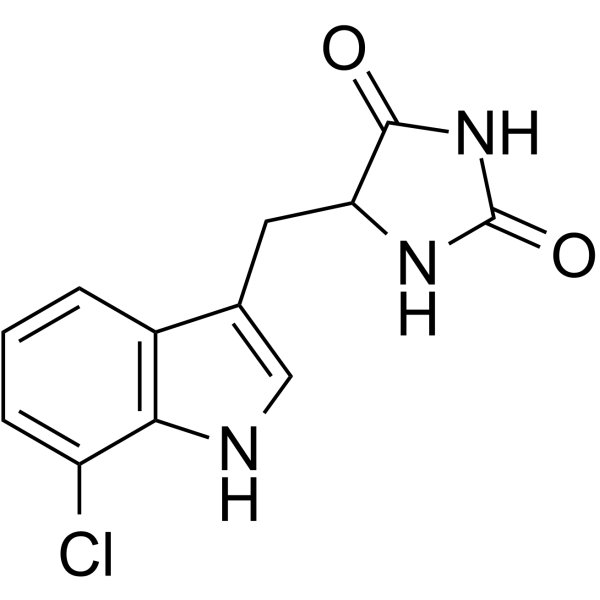Physicochemical Properties
| Molecular Formula | C12H10CLN3O2 |
| Molecular Weight | 263.679701328278 |
| Exact Mass | 263.046 |
| CAS # | 1391980-92-9 |
| PubChem CID | 78003872 |
| Appearance | White to light yellow solid powder |
| LogP | 1.7 |
| Hydrogen Bond Donor Count | 3 |
| Hydrogen Bond Acceptor Count | 2 |
| Rotatable Bond Count | 2 |
| Heavy Atom Count | 18 |
| Complexity | 376 |
| Defined Atom Stereocenter Count | 0 |
| SMILES | ClC1=CC=CC2=C1NC=C2CC1C(NC(N1)=O)=O |
| InChi Key | HAPHEBPGIQHYHN-UHFFFAOYSA-N |
| InChi Code | InChI=1S/C12H10ClN3O2/c13-8-3-1-2-7-6(5-14-10(7)8)4-9-11(17)16-12(18)15-9/h1-3,5,9,14H,4H2,(H2,15,16,17,18) |
| Chemical Name | 5-[(7-chloro-1H-indol-3-yl)methyl]imidazolidine-2,4-dione |
| Synonyms | Necroptosis-IN-1; 1391980-92-9; 5-((7-chloro-1H-indol-3-yl)methyl)imidazolidine-2,4-dione; 5-[(7-chloro-1H-indol-3-yl)methyl]imidazolidine-2,4-dione; 2,4-Imidazolidinedione, 5-[(7-chloro-1H-indol-3-yl)methyl]-; SCHEMBL15045785; |
| HS Tariff Code | 2934.99.9001 |
| Storage |
Powder-20°C 3 years 4°C 2 years In solvent -80°C 6 months -20°C 1 month |
| Shipping Condition | Room temperature (This product is stable at ambient temperature for a few days during ordinary shipping and time spent in Customs) |
Biological Activity
| Targets | RIPK |
| ln Vitro | Necrotic cell death is prevalent in many different pathological disease states and in traumatic injury. Necroptosis is a form of necrosis that stems from specific signaling pathways, with the key regulator being receptor interacting protein 1 (RIP1), a serine/threonine kinase. Specific inhibitors of RIP1, termed necrostatins, are potent inhibitors of necroptosis. Necrostatins are structurally distinct from one another yet still possess the ability to inhibit RIP1 kinase activity. To further understand the differences in the binding of the various necrostatins to RIP1 and to develop a robust high-throughput screening (HTS) assay, which can be used to identify new classes of RIP1 inhibitors, we synthesized fluorescein derivatives of Necrostatin-1 (Nec-1) and Nec-3. These compounds were used to establish a fluorescence polarization (FP) assay to directly measure the binding of necrostatins to RIP1 kinase. The fluorescein-labeled compounds are well suited for HTS because the assays have a dimethyl sulfoxide (DMSO) tolerance up to 5% and Z' scores of 0.62 (fluorescein-Nec-1) and 0.57 (fluorescein-Nec-3). In addition, results obtained from the FP assays and ligand docking studies provide insights into the putative binding sites of Nec-1, Nec-3, and Nec-4.[1] |
| References |
[1]. Fluorescence polarization assay for inhibitors of the kinase domain of receptor interacting protein 1. Anal Biochem. 2012 Aug 15;427(2):164-74. |
Solubility Data
| Solubility (In Vitro) | DMSO : 100 mg/mL (379.25 mM) |
| Solubility (In Vivo) |
Solubility in Formulation 1: ≥ 2.08 mg/mL (7.89 mM) (saturation unknown) in 10% DMSO + 40% PEG300 + 5% Tween80 + 45% Saline (add these co-solvents sequentially from left to right, and one by one), clear solution. For example, if 1 mL of working solution is to be prepared, you can add 100 μL of 20.8 mg/mL clear DMSO stock solution to 400 μL PEG300 and mix evenly; then add 50 μL Tween-80 to the above solution and mix evenly; then add 450 μL normal saline to adjust the volume to 1 mL. Preparation of saline: Dissolve 0.9 g of sodium chloride in 100 mL ddH₂ O to obtain a clear solution. Solubility in Formulation 2: ≥ 2.08 mg/mL (7.89 mM) (saturation unknown) in 10% DMSO + 90% (20% SBE-β-CD in Saline) (add these co-solvents sequentially from left to right, and one by one), clear solution. For example, if 1 mL of working solution is to be prepared, you can add 100 μL of 20.8 mg/mL clear DMSO stock solution to 900 μL of 20% SBE-β-CD physiological saline solution and mix evenly. Preparation of 20% SBE-β-CD in Saline (4°C,1 week): Dissolve 2 g SBE-β-CD in 10 mL saline to obtain a clear solution. Solubility in Formulation 3: ≥ 2.08 mg/mL (7.89 mM) (saturation unknown) in 10% DMSO + 90% Corn Oil (add these co-solvents sequentially from left to right, and one by one), clear solution. For example, if 1 mL of working solution is to be prepared, you can add 100 μL of 20.8 mg/mL clear DMSO stock solution to 900 μL of corn oil and mix evenly. (Please use freshly prepared in vivo formulations for optimal results.) |
| Preparing Stock Solutions | 1 mg | 5 mg | 10 mg | |
| 1 mM | 3.7925 mL | 18.9624 mL | 37.9248 mL | |
| 5 mM | 0.7585 mL | 3.7925 mL | 7.5850 mL | |
| 10 mM | 0.3792 mL | 1.8962 mL | 3.7925 mL |
